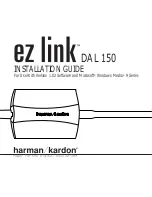
108
Technical Description
TB9100/P25 CG Installation and Operation Manual
© Tait Electronics Limited January 2007
8.4
PMU Module Operation
The PMU is available in three main configurations:
■
AC PMU (AC input only)
■
DC PMU (DC input only)
■
AC and DC PMU (both AC and DC converters are fitted to allow both
AC and DC inputs).
PMUs can only be installed in position 6 of the subrack. Refer to
“Configuring the Subrack Interconnect Board” on page 94
information.
shows the configurations for an AC and DC PMU, along with
the main inputs and outputs for power and control signals.
AC Module
The AC module accepts an input of 115/230VAC 50/60Hz nominal. The
input is fed via the PFC (power factor control) input stage to the HVDC
(high voltage DC) stage on the AC converter board. The HVDC circuitry
generates the final 28VDC outputs and provides galvanic isolation between
the mains input and DC output. The output stage on the AC converter
board provides a common output filter and current monitoring circuit
which is used by both AC and DC modules.
Each power stage is controlled by its own plug-in control card. The
microprocessor is also located on the HVDC control card. The
microprocessor is used by both the AC and DC modules and is fitted to all
PMU models.
The leaded high-power components are situated on the AC converter
board, while the plug-in cards have only SMD control components.
DC Module
The DC module accepts an input of 12, 24 or 48VDC nominal. The input
is fed through the DC input filter to the input of the power stage on the DC
converter board. This circuitry provides PWM (pulse width modulation)
conversion to produce the final DC output. It also provides galvanic
isolation, allowing the DC input to be positive or negative ground. The final
DC output is fed back to the output stage on the AC convertor board.
The battery control card monitors the DC input voltage and prevents the
PMU from starting if an incorrect input voltage is applied. It also operates
as a fail-safe to prevent deep discharge of the battery, and provides
information to the microprocessor to allow the CSS to display information
about the battery.
The DC control card controls the power stage of the DC converter. It also
provides protection from overload and short circuit conditions.
The leaded high-power components are situated on the DC converter
board, while the plug-in cards have only SMD control components.
Содержание P25 CG
Страница 60: ...60 Installation TB9100 P25 CG Installation and Operation Manual Tait Electronics Limited January 2007 ...
Страница 72: ...72 Maintenance TB9100 P25 CG Installation and Operation Manual Tait Electronics Limited January 2007 ...
Страница 76: ...76 Troubleshooting TB9100 P25 CG Installation and Operation Manual Tait Electronics Limited January 2007 ...
Страница 120: ...120 Technical Description TB9100 P25 CG Installation and Operation Manual Tait Electronics Limited January 2007 ...
Страница 146: ...146 TaitNet P25 Glossary TB9100 P25 CG Installation and Operation Manual Tait Electronics Limited January 2007 ...
















































